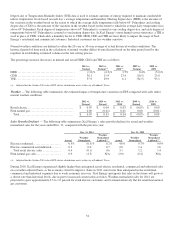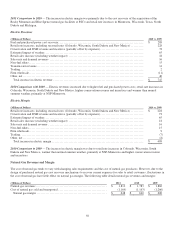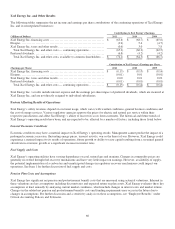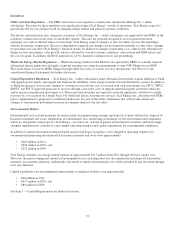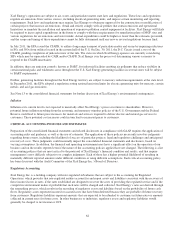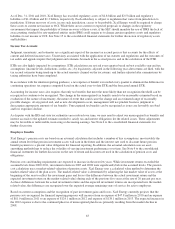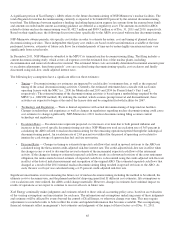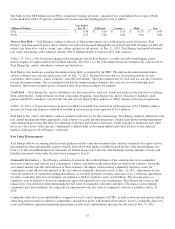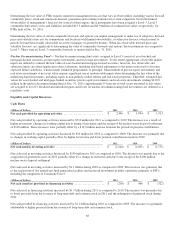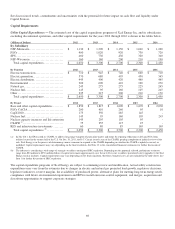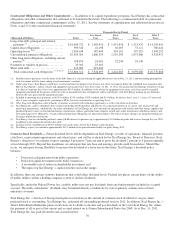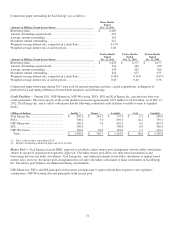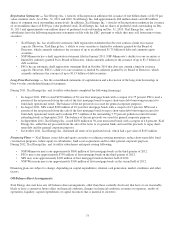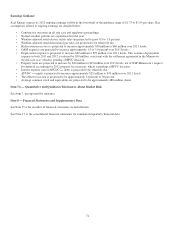Xcel Energy 2011 Annual Report Download - page 74
Download and view the complete annual report
Please find page 74 of the 2011 Xcel Energy annual report below. You can navigate through the pages in the report by either clicking on the pages listed below, or by using the keyword search tool below to find specific information within the annual report.
64
At Dec. 31, 2011, Xcel Energy set the rate of return used to measure pension costs at 7.5 percent, which is a 29 basis point
decrease from Dec. 31, 2010. The rate of return used to measure postretirement health care costs of 7.5 percent at Dec. 31, 2011
was unchanged from Dec. 31, 2010.
Xcel Energy set the discount rate used to value the Dec. 31, 2011 pension and postretirement health care obligations at 5.0
percent, which is a 50 basis point decrease from Dec. 31, 2010. Xcel Energy uses multiple reference points in determining the
discount rate, including Citigroup Pension Liability Discount Curve, the Citigroup Above Median Curve and bond matching
studies. At Dec. 31, 2011, these reference points supported the selected rate. In addition to these reference points, Xcel Energy
also reviews general actuarial survey data to assess the reasonableness of the discount rate selected.
The Pension Protection Act changed the minimum funding requirements for defined benefit pension plans beginning in 2008. The
following are the pension funding contributions, both voluntary and required, made by Xcel Energy for 2010 through 2012:
• In January 2012, contributions of $190.5 million were made across four of Xcel Energy’s pension plans;
• In 2011, contributions of $137.3 million were made across three of Xcel Energy’s pension plans;
• In 2010, contributions of $34 million were made to the Xcel Energy Pension Plan.
• For future years, we anticipate contributions will be made as necessary.
These expected contributions are summarized in Note 9 to the consolidated financial statements. These amounts are estimates and
may change based on actual market performance, changes in interest rates and any changes in governmental regulations.
Therefore, additional contributions could be required in the future.
If Xcel Energy were to use alternative assumptions at Dec. 31, 2011, a one-percent change would result in the following impact
on 2012 pension expense:
Pension Costs
(Millions of Dollars) +1% -1%
Rate of return ............................................................................ $
(29.1) $
29.6
Discount rate ............................................................................. (16.5) 19.2
Effective Dec. 31, 2011, Xcel Energy reduced its initial medical trend assumption from 6.5 percent to 6.3 percent. The ultimate
trend assumption remained unchanged at 5.0 percent. The period until the ultimate rate is reached remained unchanged at eight
years. Xcel Energy bases its medical trend assumption on the long-term cost inflation expected in the health care market,
considering the levels projected and recommended by industry experts, as well as recent actual medical cost increases
experienced by Xcel Energy’s retiree medical plan.
• Xcel Energy contributed $49.0 million and $48.4 million during 2011 and 2010, respectively, to the postretirement
health care plans.
• Xcel Energy expects to contribute approximately $39.1 million during 2012.
Xcel Energy recovers employee benefits costs in its regulated utility operations consistent with accounting guidance with the
exception of the areas noted below.
• NSP-Minnesota recognizes pension expense in all regulatory jurisdictions based on expense as calculated using the
aggregate normal cost actuarial method. Differences between aggregate normal cost and expense as calculated are
deferred as a regulatory liability.
• Colorado, Texas, New Mexico and FERC jurisdictions allow the recovery of other post retirement benefit costs only to
the extent that recognized expense is matched by cash contributions to an irrevocable trust. Xcel Energy has consistently
funded at a level to allow full recovery of costs in these jurisdictions.
See Note 9 to the consolidated financial statements for further discussion.
Nuclear Decommissioning
Xcel Energy recognizes liabilities for the expected cost of retiring tangible long-lived assets for which a legal obligation exists.
These AROs are recognized at fair value as incurred and are capitalized as part of the cost of the related long-lived assets. In the
absence of quoted market prices, Xcel Energy estimates the fair value of its AROs using present value techniques, in which it
makes various assumptions including estimates of the amounts and timing of future cash flows associated with retirement
activities, credit-adjusted risk free rates and cost escalation rates. When Xcel Energy revises any assumptions used to estimate
AROs, it adjusts the carrying amount of both the ARO liability and the related long-lived asset. Xcel Energy accretes ARO
liabilities to reflect the passage of time using the interest method.


